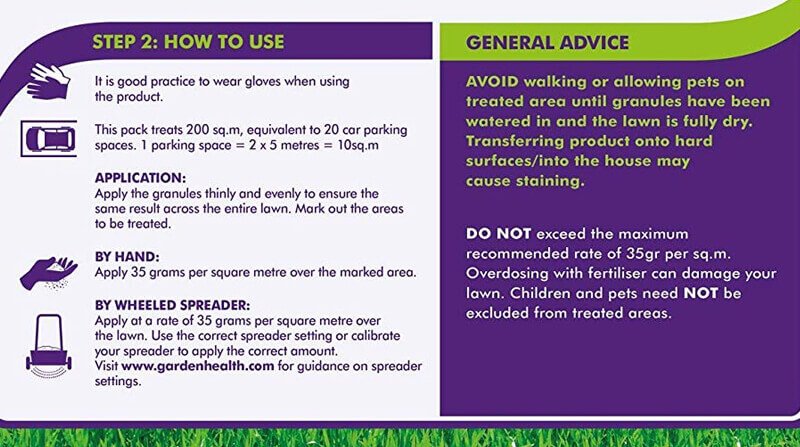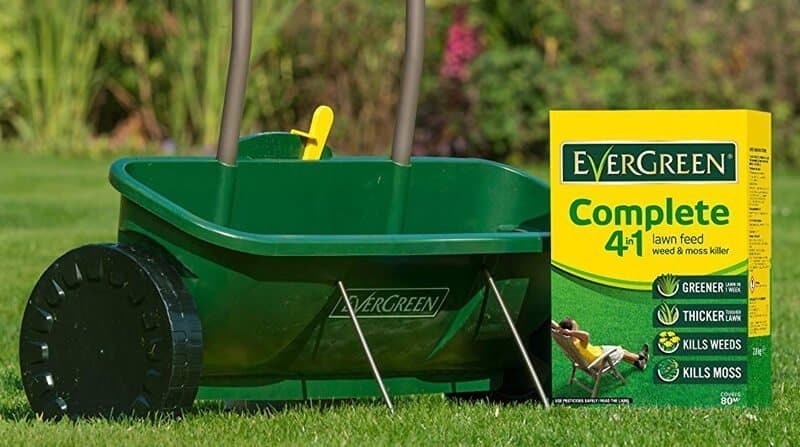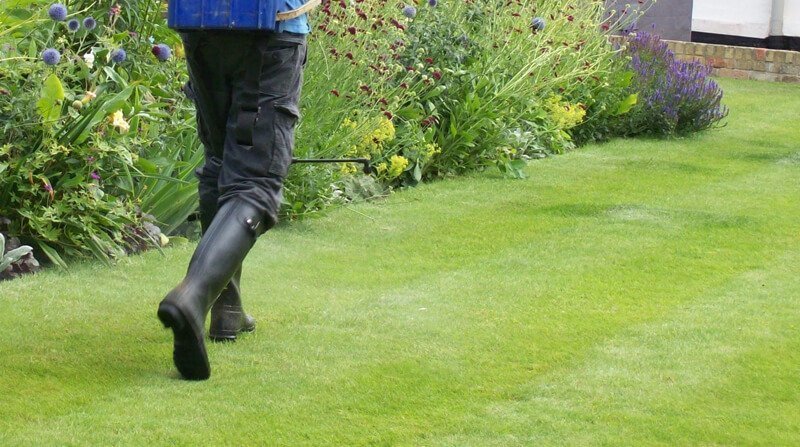When it comes to feeding a lawn, many gardeners get it wrong, either by applying too much not enough.
So the question is, ‘How much lawn feed should you apply?’
This can often be a difficult question to answer because there are so many variables including;
- The manufacturer
- Whether it’s a liquid or granular feed
- What the NPK values are
- The time of year
- The weather
And many others.
So in this article, I want to try and give you my best advice.
The Manufacturers Guidelines

All lawn fertiliser products come with a recommended application rate. So, the first thing you should do is look at the label.
In the example above, the label advises you to spread 35 grams of lawn feed per square meter.
So for a 100sqm lawn, you’d need 3.5kg of lawn feed.
However, you shouldn’t just follow this advice blindly.
Why You Shouldn’t Always Stick to the Advice on the Label
So what’s the point in manufacturers putting application rates on their products if we’re going to ignore them?
Firstly, it’s important to understand that the application rates are the maximum you should apply.
In the image above there is a warning which says, ‘DO NOT exceed the maximum recommended rate of 35g per sq.m.’
However, not all manufacturers make this obvious.
But there are several reasons why you shouldn’t just blindly apply the maximum dose.
There’s Too Much Nitrogen in Most Domestic Fertilisers
When it comes to domestic lawn fertilisers, a manufacturer’s primary goal is to make you think the product has worked. As quickly as possible.
You apply it and you watch the lawn get greener and growth increase over the next few days. You’re happy that it’s worked and so next time you need to feed the grass you buy their product again.
The primary ingredient which is responsible for this growth and greening is Nitrogen.
As a result, manufacturers put lots of Nitrogen in their fertilisers to make sure this happens quickly.
However, this growth and greening often happen at the expense of healthy root development. The roots grow too quickly.
This root growth causes another problem which isn’t immediately obvious.
It speeds up the build-up of lawn thatch.
New roots grow much quicker than the microbes in the soil are able to break down dead grass roots and other organic matter. As a result, the build-up thatch happens quicker than it would normally.
The Type of Grasses Your Lawn is Made Up Of
Depending on the type of grass your lawn is made up it’s advisable to spread less fertiliser.
For example, an ornamental lawn that is made up of fine fescue grasses naturally produces a lot of thatch so applying lots f fertiliser will make the problem worse. They also don’t take well to heavy applications of fertiliser, taking on a bluey colour so it’s always best to be cautious.
For ornamental lawns, I’d apply a lower dose of 20g per square meter.
On the other hand, lawn made up of ryegrass it will be happy with a higher dose, in which case 25g – 30g per square meter will be enough.
If need be, you can always apply a little a liquid feed a few weeks later on but again, liquid feeds generally contains lots of Nitrogen so half the dose.
The Weather
The weather also plays a role in when you feed the lawn, but also the amount of fertiliser you apply.
If there is plenty of rain and growing conditions are good, apply it at the higher end of the application rate.
So 25g per m2 for an ornamental lawn and 30g per m2 for a regular lawn.
If ground moisture is available but not much rain, stick to the lower end of the scale.
20g per m2 for an ornamental lawn, 25g per m2 for a regular lawn.
If it’s hot and dry, don’t apply fertiliser at all as it could result in scorched, brown grass.
Why You Need to Be Careful With Weed and Feed Products

When it comes to using weed and feed products you need to be very careful and make sure you apply the correct amount.
If you apply too much, the Nitrogen content can damage the grass but then so can the weed killer. If it contains moss killer too, your grass can suffer quite badly.
With this in mind, the logic might be to apply less than the recommended dose in the same way I recommend with a regular lawn feed. However, if don’t apply enough you won’t kill the weeds.
This is why I always prefer to use a separate fertiliser, selective weed killer and moss killer.
Yes, it costs a bit more because I need to buy 3 separate products, and it takes more time to apply them. That said, it means I control how much of each I apply which is a much safer way of doing it.
In Conclusion
Now I’m not saying domestic fertilisers are bad, they’re not.
And besides, they’re all that’s available to amateur gardeners. Professional products are not only extremely expensive in comparison, but they also take a much deeper knowledge and understanding in order to use them.
When used with a bit of knowledge, domestic lawn feeds are very good products (some more than others).
That said, it’s worth learning how to apply granular fertilisers and how to apply liquid feeds to make sure you don’t apply too much.
Just remember that grass is a hardy plant and it needs less fertiliser than you might think to stay healthy and strong.
And underfeeding is always better than overfeeding.

